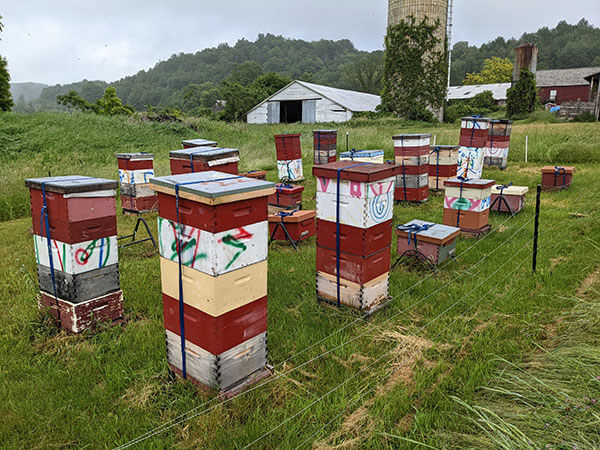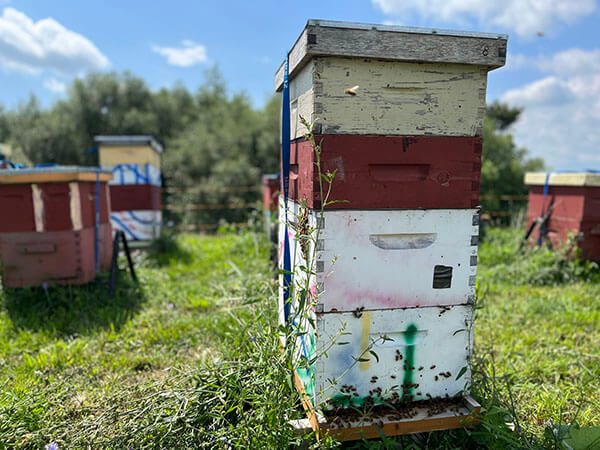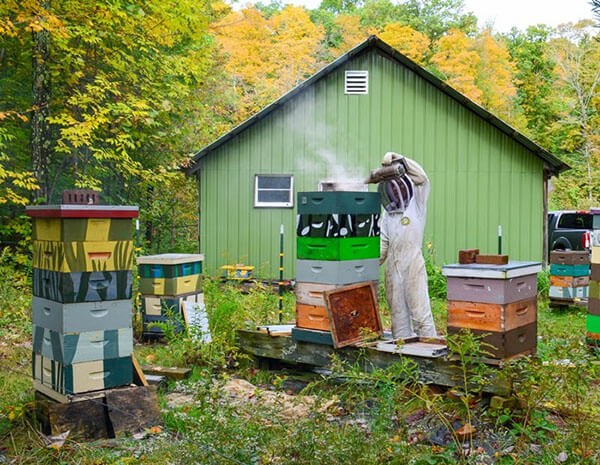"What size brood boxes and honey boxes (supers) would you like?"
When you buy your first hive, this will likely be the first question you're asked. Many would-be beekeepers reply, "What's the difference?" This early choice you make for your equipment really is a question of how you feel about weight and standardization.
These boxes are where your bees live and produce honey. The stack of boxes we call a hive is only walls, with a bottom board at the very bottom, and covers at the very top. The interior volume changes from a squat rectangle in spring to a tall rectangle during the summer, and returns to a rather short size for winter, as the beekeeper adds or removes boxes.
Remember that there's nothing special about any boxes as far as the bees are concerned. They'll live in a box of just about any shape or size. Your choice is really mostly about what works best for your beekeeping needs, and the bees will accept whatever you choose.
A beginner's first decision concerns the lowest boxes: the brood boxes
In Year One, your bees might only need brood boxes and may not build enough comb to start filling honey supers. Brood is the term for young bees, ranging from the eggs the queen laid up through the baby bees chewing out of their hexagonal cells as adult bees. Later on - maybe during your first summer or else in spring of your second year - the honey storage boxes ("supers") need to be ready to put on the hive too, but colonies grow best if allowed to fill their brood boxes first before more space is added.
The usual beginner hive kit consists of two "deep" (9-1/2 inches high) brood boxes and some number of "medium" (6 inches high) honey supers. In its second year of life, a strong colony might need 4 medium supers. But just because certain box sizes come in the standard beginner's kit, that doesn't mean those box sizes are right for you!
There's also a third box height, called a "shallow." A shallow is 5-11/16 inches tall. Shallows were more common pre-1960s, when the new "medium" was introduced. Some folks mistakenly call mediums shallows because they're completely unaware of shallows! Shallows are nice as a choice for supers because of the lower weight, but they are never used as brood boxes. It's best to avoid using both shallow and medium supers, as they are easily mistaken for each other. For some reason, mediums have become more popular, but using shallow supers could be a key way to make beekeeping possible for people who have trouble with lifting.
How heavy are these boxes anyway?
The chief reason to choose one box size over another is their weight once the bees have filled them. Brood is light compared to honey, and the bees arrange their home with brood below food (pollen and honey). For most of the season, the bottom box will typically contain only brood, and the top super will contain only honey or nectar. The topmost brood box will often contain a mix of brood, honey, and pollen. Thus, the highest boxes usually hold the heaviest stuff, with the contents getting lighter as you move down the hive.
Honey super weight comparisons
- Wooden deep 10 frame box full of honey: 60-70 lbs
- Wooden medium 10 frame box full of honey: 40-50 lbs
- Wooden shallow 10 frame box full of honey: 30-35 lbs
The "standard" hive set-up: Deeps for brood boxes and mediums for supers
Pros:
- Tried and true hive set-up, used by many beekeepers around the world.
- Most beekeeping writers and speakers you encounter will assume you are using these box sizes, since it's most common. If you do anything differently, you'll always need to convert sizes in your head as you read or listen.
- Even bee medicines (like miticides) assume you will be using two deep boxes for brood, so you may have to carefully interpret instructions if using another configuration.
- People who grow and sell bees (nucleus colonies) typically use deep equipment, so you usually need deep brood boxes if you want to buy nucs. (Of course, package bees can be installed in equipment of any size.)
- Weights are distributed based on likely lifting. Heavy honey supers are mediums, while lighter brood boxes are deeps. Bees fill deeps with honey for the winter, but you typically do not lift those heavy boxes until spring, when the honey has all been eaten.
Cons:
- The top deep of a "two deeps" brood chamber often fills with honey in later summer as the bees begin storing food for winter.
- You may need to move heavy deeps full of honey under some circumstances, which can be too much for some beekeepers to lift. (Though remember that you can always pull a few frames out of a too-heavy box, set them aside, manipulate the box, and then replace the frames.)
- Because you have both deep and medium frames in your hive, you can't simply pop a frame up or down between your brood boxes and your honey supers.
An increasingly common alternative: All-medium hives
More and more beekeepers are opting to exclusively use medium-depth boxes. The volume of the brood chamber and square inches of comb inside 3 mediums is just a tad larger than the space in 2 deeps, but it's so close that we describe 3 mediums and 2 deeps as equivalent. In this option, you'd use 3 mediums for brood, and then 3-4 more medium supers for the honey. Our Head Beekeeper Anne has always been grateful to the person who started her out, for steering her towards the simplicity of an all-medium set-up.
Pros:
- You'll never, ever, have to lift a deep full of honey if there are no deeps in your operation. For people who cannot (or don't want to) heft boxes that big, this option eliminates the possibility.
- Each frame and box is 2/3 the height of a deep, and thus lighter. Remember you're also choosing frame height when you choose your box height! If you're examining multiple hives, the lighter weight of each frame for fingers, wrists, and shoulders during this repetitive task feels significant by the end of a few hours.
- Standardizing frame size across all of your equipment is also very useful. Every box and frame matches and you have a lot of leeway to use them in flexible ways. Frames of honey from up in the supers can easily be placed in a brood box below, for example. Honey supers can easily become brood boxes as time goes on.
Cons:
- One commonly-cited "con" of all-mediums is that you need to look through 50% more frames when inspecting the brood area. In 3 medium boxes there are 30 frames, vs. 20 frames in the "two deeps" brood chamber. This is a valid concern, though keep in mind how infrequently a beekeeper actually pulls out and examines every single brood frame.
- Another concern is that since nucs usually come with deep frames, using a "3 mediums" brood chamber prevents you from buying nucs if you need to buy new bees.
- Since each brood frame is smaller, the brood combs are interrupted by wooden frame parts and gaps more often in an all-medium brood nest. (Though we haven't found this to cause any significant disturbance to the bees.)
Other options: How about all-deeps? Or bringing shallows into the mix? How crazy should you get?!
Using nothing but deep boxes is a choice often made by commercial beekeepers, giving the benefit of standardized box and frame sizes, and also reducing the total number of hive parts needed for any one hive. They can also get away with this because a commercial beekeeper's hired help is usually young, strong, and replaceable. The Seeley honey bee research lab at Cornell also used all-deep hives, for similar reasons - tired grad students graduate and are always replaced by young new ones who are willing to lift deep honey supers!
There are plenty of other variations you can consider. Some beekeepers use only a single deep as a brood chamber, while some use a medium and a deep for the brood chamber. These are possibilities you should leave until you've mastered the basics, with either two deeps or three mediums to provide your bees with a relatively large brood area and enough room to accommodate an overcrowded hive in swarming season.
There are plenty of ways to stack your boxes. If you wanted, you could use a pile of shallows as your brood boxes, and then put one or two giant deep-sized honey supers on top of them. You shouldn't, but you could. It's your apiary, your back, and your sanity. The bees will adapt to many different configurations if you offer them (though even bees have their limits). If you're getting started with bees, think carefully about which of these options best suits you.
Check out this Betterbee YouTube Video that covers these topics: Choosing Your Boxes.
Of course, once you choose your box depth, you also have to choose how many frames you'd like per box. Check out Choosing Equipment: 8 Frame vs. 10 Frame Boxes!



